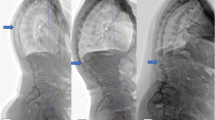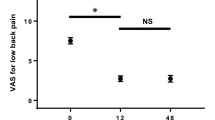Abstract
Propose
To determine whether depression in postmenopausal women with osteoporosis is associated with an increased risk of thoracolumbar fragility fracture.
Methods
Postmenopausal women with osteoporosis and without prior vertebral fracture history who were seen at our institution from January 2006 to January 2010 (n = 1397) were divided into depression group (n = 494) and depression-free group (n = 903). After at least 4 years the incidence of thoracolumbar osteoporotic vertebral fracture was compared between the groups. For those who developed vertebral fracture, quality of life over the subsequent 2 months and fracture pain in the subsequent 2 weeks were compared. Depression was assessed with the 21-item Beck Depression Inventory, pain intensity with the visual analogue scale and quality of life with the Medical Outcomes Study 36-item Short-Form Survey.
Results
The incidence of thoracolumbar fractures among women with continuous depression was higher than the group without depression (35.43 vs. 25.14 %, respectively; (P < 0.05). Osteoporotic thoracolumbar fractures were associated with significantly lower quality of life scores in women with depression than in those without depression (P < 0.05). Fracture pain was experienced by a higher percentage of patients with continuous depression than by those without depression (44.00 vs. 27.31 %; P < 0.05).
Conclusion
Depression is associated with a higher risk of thoracolumbar fracture, with more fracture pain and with lower quality of life in the 2 months following fracture.

Similar content being viewed by others
References
Rizzoli R, Bruyere O, Cannata-Andia JB, Devogelaer J, Lyritis G, Ringe JD, Vellas B, Reginster J (2009) Management of osteoporosis in the elderly. Curr Med Res Opin 25(10):2373–2387. doi:10.1185/03007990903169262
Givens JL, Sanft TB, Marcantonio ER (2008) Functional recovery after hip fracture: the combined effects of depressive symptoms, cognitive impairment, and delirium. J Am Geriatr Soc 56(6):1075–1079. doi:10.1111/j.1532-5415.2008.01711.x
Ustun TB, Ayuso-Mateos JL, Chatterji S, Mathers C, Murray CJ (2004) Global burden of depressive disorders in the year 2000. Br J Psychiatry J Ment Sci 184:386–392
Timur S, Sahin NH (2010) The prevalence of depression symptoms and influencing factors among perimenopausal and postmenopausal women. Menopause 17(3):545–551. doi:10.1097/gme.0b013e3181cf8997
Dormaenen A, Heimdal MR, Wang CE, Grimsgaard AS (2011) Depression in postmenopause: a study on a subsample of the acupuncture on hot flushes among menopausal women (ACUFLASH) study. Menopause 18(5):525–530. doi:10.1097/gme.0b013e3181f9f89f
Barth J, Schumacher M, Herrmann-Lingen C (2004) Depression as a risk factor for mortality in patients with coronary heart disease: a meta-analysis. Psychosom Med 66(6):802–813. doi:10.1097/01.psy.0000146332.53619.b2
Anisman H, Merali Z, Hayley S (2008) Neurotransmitter, peptide and cytokine processes in relation to depressive disorder: comorbidity between depression and neurodegenerative disorders. Prog Neurobiol 85(1):1–74. doi:10.1016/j.pneurobio.2008.01.004
Everson-Rose SA, Meyer PM, Powell LH, Pandey D, Torrens JI, Kravitz HM, Bromberger JT, Matthews KA (2004) Depressive symptoms, insulin resistance, and risk of diabetes in women at midlife. Diabetes Care 27(12):2856–2862
Onyike CU, Crum RM, Lee HB, Lyketsos CG, Eaton WW (2003) Is obesity associated with major depression? Results from the third national health and nutrition examination survey. Am J Epidemiol 158(12):1139–1147
Ding H, Tang Y, Xue Y, Yang Z, Li Z, He D, Zhao Y, Zong Y (2014) A report on the prevalence of depression and anxiety in patients with frozen shoulder and their relations to disease status. Psychol Health Med. doi:10.1080/13548506.2013.873814
Zong Y, Xue Y, Zhao Y, Ding H, He D, Li Z, Tang Y, Wang Y (2014) Depression contributed an unsatisfactory surgery outcome among the posterior decompression of the cervical spondylotic myelopathy patients: a prospective clinical study. Neurological Sci Official J Ital Neurol Soc Ital Soc Clin Neurophysiol. doi:10.1007/s10072-014-1714-8
Cizza G, Ravn P, Chrousos GP, Gold PW (2001) Depression: a major, unrecognized risk factor for osteoporosis? Trends Endocrinol Metab TEM 12(5):198–203
Beck AT, Ward CH, Mendelson M, Mock J, Erbaugh J (1961) An inventory for measuring depression. Arch Gen Psychiatry 4:561–571
Reips UD, Funke F (2008) Interval-level measurement with visual analogue scales in Internet-based research: VAS generator. Behav Res Methods 40(3):699–704
Fuh JL, Wang SJ, Lu SR, Juang KD, Lee SJ (2000) Psychometric evaluation of a Chinese (Taiwanese) version of the SF-36 health survey amongst middle-aged women from a rural community. Qual Life Res Int J Qual life Asp Treat Care Rehabil 9(6):675–683
Cizza G, Primma S, Csako G (2009) Depression as a risk factor for osteoporosis. Trends Endocrinol Metabol TEM 20(8):367–373. doi:10.1016/j.tem.2009.05.003
Kanis JA (2002) Diagnosis of osteoporosis and assessment of fracture risk. Lancet 359(9321):1929–1936. doi:10.1016/S0140-6736(02)08761-5
Syed Z, Khan A (2002) Bone densitometry: applications and limitations. J Obstet Gynaecol Can JOGC 24(6):476–484
Lyles KW, Colon-Emeric CS, Magaziner JS, Adachi JD, Pieper CF, Mautalen C, Hyldstrup L, Recknor C, Nordsletten L, Moore KA, Lavecchia C, Zhang J, Mesenbrink P, Hodgson PK, Abrams K, Orloff JJ, Horowitz Z, Eriksen EF, Boonen S, for the HRFT (2007) Zoledronic Acid in Reducing Clinical Fracture and Mortality after Hip Fracture. N Engl J Med 357:nihpa40967. doi:10.1056/NEJMe074941
Silverman SL, Shen W, Minshall ME, Xie S, Moses KH (2007) Prevalence of depressive symptoms in postmenopausal women with low bone mineral density and/or prevalent vertebral fracture: results from the Multiple Outcomes of Raloxifene Evaluation (MORE) study. J Rheumatol 34(1):140–144
Tolea MI, Black SA, Carter-Pokras OD, Kling MA (2007) Depressive symptoms as a risk factor for osteoporosis and fractures in older Mexican American women. Osteoporos Int 18(3):315–322. doi:10.1007/s00198-006-0242-7
Forsen L, Meyer HE, Sogaard AJ, Naess S, Schei B, Edna TH (1999) Mental distress and risk of hip fracture. Do broken hearts lead to broken bones? J Epidemiol Community Health 53(6):343–347
Mussolino ME (2005) Depression and hip fracture risk: the NHANES I epidemiologic follow-up study. Public Health Rep 120(1):71–75
Whooley MA, Kip KE, Cauley JA, Ensrud KE, Nevitt MC, Browner WS (1999) Depression, falls, and risk of fracture in older women. Study of Osteoporotic Fractures Research Group. Arch Intern Med 159(5):484–490
McLeod KM, Johnson CS (2011) A systematic review of osteoporosis health beliefs in adult men and women. Journal of osteoporosis 2011:197454. doi:10.4061/2011/197454
Papaioannou A, Kennedy CC, Ioannidis G, Brown JP, Pathak A, Hanley DA, Josse RG, Sebaldt RJ, Olszynski WP, Tenenhouse A, Murray TM, Petrie A, Goldsmith CH, Adachi JD (2006) Determinants of health-related quality of life in women with vertebral fractures. Osteoporos Int 17(3):355–363. doi:10.1007/s00198-005-2020-3
Greendale GA, Barrett-Connor E, Ingles S, Haile R (1995) Late physical and functional effects of osteoporotic fracture in women: the Rancho Bernardo Study. J Am Geriatr Soc 43(9):955–961
Huang C, Ross PD, Wasnich RD (1996) Vertebral fracture and other predictors of physical impairment and health care utilization. Arch Intern Med 156(21):2469–2475
Madureira MM, Ciconelli RM, Pereira RM (2012) Quality of life measurements in patients with osteoporosis and fractures. Clinics 67(11):1315–1320
Acknowledgments
All the work was supported by the National Natural Science Foundation of China (No.81271360). Yaqi Zong and Yanming Tang are the co-first authors. Each author has made an important scientific contribution to the study and is thoroughly familiar with the primary data. All authors listed have read the complete manuscript and have approved submission of the paper. The manuscript is truthful original work without fabrication, fraud or plagiarism.
Conflict of interest
All authors declare that they have no conflicts of interest.
Author information
Authors and Affiliations
Corresponding author
Rights and permissions
About this article
Cite this article
Zong, Y., Tang, Y., Xue, Y. et al. Depression is associated with increased incidence of osteoporotic thoracolumbar fracture in postmenopausal women: a prospective study. Eur Spine J 25, 3418–3423 (2016). https://doi.org/10.1007/s00586-015-4033-8
Received:
Revised:
Accepted:
Published:
Issue Date:
DOI: https://doi.org/10.1007/s00586-015-4033-8




